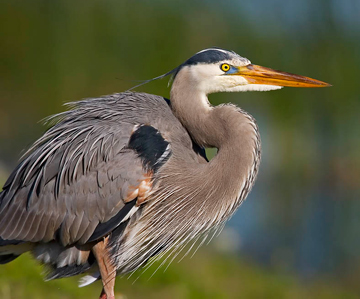|
Trail Guides
|
Raccoon Creek Wildlife Management Area
|
6
 
|
Route 322, Logan Township & Woolwich Township, NJ
Phone: (856) 629-0090
www.state.nj.us/dep/fgw/wmas.htm
NJ Department of Environmental Protection
Exit Lake Narraticon Park via Park Avenue, and turn Left at the “T” intersection onto Lake Avenue. Make the first Right onto Route 551 North. After 0.5 miles turn Left onto Swedesboro-Paulsboro Road. After 0.6 miles turn Left onto Route 322. After 1.4 miles turn Left at the traffic light onto Berkely Drive. Continue through the industrial park to the cul-de-sac end. A dirt road leads from the cul-de-sac into Raccoon Creek Wildlife Management Area. DIRECTIONS FROM NEAREST HIGHWAY: From I-295, take exit 11A for Route 322 East. Turn Right at the first traffic light onto Berkely Drive. Continue through the industrial park to the cul-de-sac end. A dirt road leads from the cul-de-sac into Raccoon Creek Wildlife Management Area. Map
 |
| Great Blue Heron | Kevin Karlson |
| |
| | Raccoon Creek Wildlife Management Area is easily accessible and has a variety of habitats in a small area of land. The marshlands surrounding Raccoon Creek, accessible from trails through the woods, are great places for wading birds, shorebirds, ducks and other waterfowl. The mowed fields by the industrial park host grassland species and butterflies. There is also successional forest habitat, good for passerines, deer and other mammals. The dirt roads and maintained trails make the WMA easy to explore by car or on foot.
The huge old sycamore tree along the dirt road is a must-see any time of year, and is most photogenic in October.
Wintering ducks include Mallards and Black Duck. Look for Bald Eagle over the creek. Winter resident songbirds include White-throated Sparrow, Swamp Sparrow and the year-round reliables, like cardinals and Blue Jays. The leafless trees make viewing easier. Owls nest and can be heard calling at dusk. Track wild turkeys and mammals in the snow.
Wading birds and ducks are among the migrants that use the river edge. Swallows are acrobatically arcing over the water. Many passerine migrants are passing through, while some species, such as the Yellow Warbler, Indigo Bunting and Common Yellowthroat stay and nest. Early butterflies hover over the fields.
Nesting passerines include several sparrows, warblers and wrens. Northern Orioles prefer the tulip trees near the water. Families of Wild Turkey move through the fields. Butterflies such as monarch, yellow sulfur, silver-spotted skipper, black swallowtail, and Eastern tailed blue are flitting about the fields. Many mammals' offspring are venturing out such as skunk, deer and chipmunk.
Migrating waterbirds, both waders and waterfowl, are passing through again. Turkey Vultures glide above and an occasional Northern Harrier or Osprey can be spotted. Check the fences surrounding the retention pond for Belted Kingfisher.
Two more access points to the WMA can be found further East along Route 322, 0.2 and 0.5 miles on the Right. Both of these entrances are shared with either companies or private residences, so use caution if driving in and obey all signage.
|
|
|